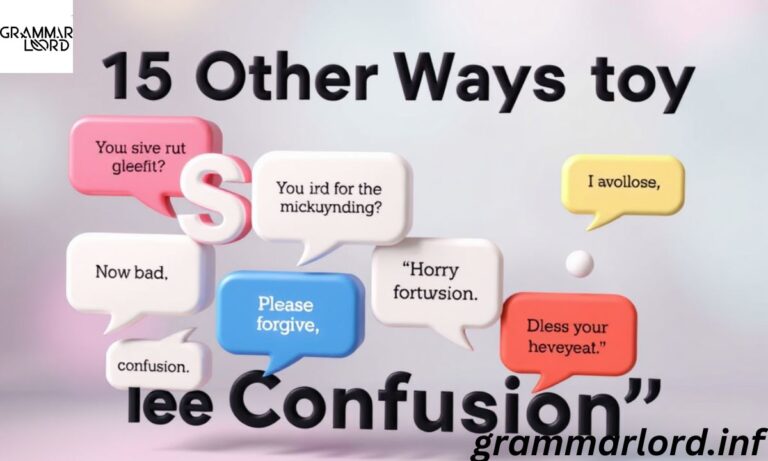Miscommunication can happen in any conversation, and it’s important to address it politely and professionally. Instead of simply saying, “Sorry for the confusion,” you can use various alternative phrases to express your apology more effectively. Whether you’re in a formal setting or a casual conversation, the right wording can help clarify your message and maintain positive communication.
Main Points
Misunderstandings can happen in any conversation, and addressing them properly is essential. A well-phrased apology can help clear up any confusion while maintaining a professional and respectful tone.
Instead of simply saying “Sorry for the confusion,” you can use various alternative expressions. Each phrase conveys sincerity while ensuring clarity in communication. Below are different ways to apologize and clarify misunderstandings effectively.
Apologies for the Misunderstanding
Sometimes, messages may not come across as intended, leading to confusion. In such cases, acknowledging the misunderstanding helps rebuild trust.
Saying “Apologies for the misunderstanding” shows that you recognize the issue. This phrase is professional, polite, and suitable for both formal and casual conversations. It reassures the other person that you value clear communication.
My Mistake
Taking responsibility for an error is an important part of effective communication. Saying “My mistake” is a simple yet honest way to own up to a misunderstanding.
It works well in both professional and informal settings. This phrase conveys accountability without being overly formal. It’s a great way to acknowledge errors while keeping the conversation moving forward.
Accept My Apologies

A more formal way to apologize, “Accept my apologies,s” is often used in professional settings. This phrase conveys a sense of sincerity and responsibility.
It is particularly useful in emails, business communication, or customer service situations. By using this, you ensure the other person feels heard and respected. It helps maintain strong relationships despite the confusion.
Clarification Needed
Sometimes, confusion arises due to a lack of clarity in communication. Instead of apologizing outright, you can say, “Clarification needed,” to indicate a need for better understanding.
This phrase is useful in professional settings where precision matters. It shifts the focus from blame to resolving the issue. This approach fosters effective discussions and reduces misunderstandings.
Apologies for the Mix-Up
Mistakes and misinterpretations can lead to unnecessary confusion. Saying “Apologies for the mix-up” acknowledges the situation without over-explaining.
This phrase is commonly used when schedules, details, or instructions get miscommunicated. It is polite and professional and works well in workplace interactions. By using this phrase, you show consideration while keeping things light.
Let Me Clarify
Instead of just apologizing, sometimes it’s helpful to provide an immediate correction. Saying “Let me clarify” ensures that you take responsibility while also resolving the issue.
This phrase is especially useful in conversations where accuracy is crucial. It helps redirect the discussion toward clarity instead of dwelling on the mistake. Using it keeps communication smooth and efficient.
Pardon the Error
A slightly more formal way to acknowledge a mistake is by saying, “Pardon the error.” This phrase is polite and professional, making it suitable for business interactions.
It expresses accountability while keeping the tone neutral. It’s particularly useful in emails and reports where a correction is required. This phrase helps maintain credibility and professionalism.
For the Misinterpretation
Misinterpretations happen when messages are understood differently than intended. A good way to address this is by saying, “For the misinterpretation, I apologize.”
This phrase is formal and acknowledges the confusion directly. It is particularly useful when explaining a situation to colleagues or clients. Taking responsibility in this manner helps maintain clarity in communication.
Regret the Misunderstanding
If a misunderstanding has led to an issue, expressing regret can help ease tensions. Saying “I regret the misunderstanding” conveys professionalism and sincerity
It works well in situations where an apology needs to be more formal. This phrase reassures the other party that you acknowledge the issue. It also sets the stage for clear and constructive dialogue moving forward.
Acknowledge the Confusion
When communication leads to confusion, acknowledging it is a great first step. Saying “I acknowledge the confusion” shows that you recognize the issue and are willing to address it.
This phrase is useful in discussions where multiple perspectives exist. It helps create a collaborative tone instead of placing blame. Taking this approach leads to more productive and respectful conversations.
Apologies for the Discrepancy
When details don’t align, addressing the inconsistency is crucial. Saying “Apologies for the discrepancy” works well in professional settings, especially in reports or data-driven discussions.
This phrase recognizes the error while keeping the tone neutral. It is especially effective when dealing with numbers, documents, or formal agreements. Using it helps smooth out misunderstandings in a composed manner.
Apologies for Any Misconceptions
Misconceptions can lead to confusion, and addressing them appropriately is key. Saying “Apologies for any misconception” acknowledges the possibility of misunderstanding without assuming blame.
This phrase works well in professional and academic discussions. It helps clarify perspectives while keeping the conversation respectful. Using it ensures a diplomatic resolution to any confusion.
Please Excuse the Confusion

A polite and gentle way to acknowledge a misunderstanding is to say, “Please excuse the confusion.” This phrase is slightly more formal but still widely applicable.
It works well in emails, meetings, and customer interactions. It maintains a courteous tone while acknowledging the issue. This approach helps keep communication smooth and professional.
Apologies for the Oversight
Mistakes happen, and sometimes things get overlooked. Saying “Apologies for the oversight” professionally conveys responsibility. This phrase is best used in situations where an error was unintentional but needs correction.
It reassures others that you are aware of the mistake and willing to fix it. Using this phrase helps maintain credibility and trust.
My Sincere Apologies
For more serious misunderstandings, a heartfelt apology is necessary. Saying “My sincere apologies” adds depth and emotion to your regret.
This phrase is best used when an error has caused inconvenience or frustration. It conveys genuine remorse and professionalism at the same time. Using it helps restore goodwill and strengthens relationships.
Frequently Asked Questions
Why is it important to apologize for confusion?
Apologizing helps maintain professionalism, clear up misunderstandings, and build stronger relationships.
What is a formal way to say “Sorry for the confusion”?
You can say, I apologize for any misunderstanding or My sincere apologies for the confusion.
How can I apologize without taking full blame?
Use phrases like I see how that could be unclear or Let me clarify to avoid any misunderstanding.
What’s a polite way to say “My mistake” in business emails?
I will try to take responsibility for the oversight or apologize for the discrepancy.
When should I use a casual vs. a formal apology?
Use casual phrases in informal settings and professional ones in workplaces, emails, or customer interactions.
Conclusion
Effective communication is essential in both personal and professional settings, and misunderstandings are bound to happen. Knowing how to apologize properly helps maintain clarity, professionalism, and strong relationships.
Instead of using the common phrase “Sorry for the confusion,” you can choose from various alternatives that best fit the situation. Whether you want to sound formal, professional, or casual, using the right words can make a significant difference in how your message is received.

